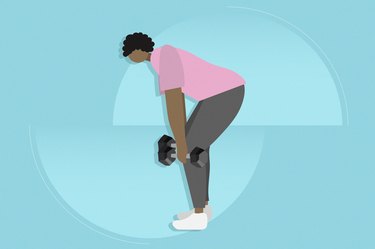
Being a parent or caregiver to a small child requires an endless amount of stamina. You need serious mental endurance to persist through the sleepless nights, teething stages and tantrums.
But parenting also involves a ton of physical strength as well. Just ask anyone who's ever held a wriggling toddler. Yep, carrying a baby can be super strenuous on your body, especially as your little one grows heavier.
Video of the Day
"Imagine going to the gym and picking up a 15, 25 or 35-pound weight and then carrying it around for the next hour (or maybe even for the rest of the day)," Sarah Duvall, DPT, CPT, a physical therapist, certified personal trainer and founder of Core Exercise Solutions, says.
"It would get exhausting, and you'd feel tension and pain from overusing those specific carrying muscles," Duvall says. This is exactly what happens when you hold your child for prolonged periods of time.
While you can't turn back time to the newborn days when your child was light as a feather, you can prepare your kid-carrying muscles and make lifting the weight a bit easier on your body through targeted strength exercises.
"Weight training and exercise (especially during the newborn period) can help your body feel strong and ready to take on the challenge of parenting," Duvall says.
4 Strength Exercises to Help Carry a Child Every Day
"To help alleviate tension and build strength in the areas that are needed to carry a child, you'll want to focus not only on arm strength, but scapular and core strength as well," Duvall says.
The following exercises target your shoulders, core, back and biceps to strengthen the muscle groups that bear the weight (literally) of lifting a little one every day.
You can either incorporate the movements into your existing workouts or combine them into a circuit for a complete workout.
1. Suitcase Carry
This core-strengthening exercise helps ease strain from your back, particularly when carrying a heavy child, Duvall says.
Plus, as a unilateral exercise, the suitcase carry can address muscle imbalances, which become common when you lift a tyke every day. That's because most of us tend to carry a baby on one side, putting excessive stress on the same set of muscles.
"Unilateral exercises help strengthen a specific side, especially when someone has a favored side for carrying their child," Duvall says.
And while you might assume the side you prefer for holding your child is stronger, it's often the opposite.
"If you typically carry a child on your left side, that means your right abdominals are doing the work to support the weight," and your left side will likely be weaker, Duvall says.
"To work those left abs [i.e., the weaker muscles], you'd need to carry a weight in the right hand to target the left abdominals," she says.
So how can you ensure that both sides of your body are balanced? "As an easy rule of thumb, I recommend doing double, or, at the very least, an extra set [of exercises], for the weaker side," Duvall says.
- Place a dumbbell or kettlebell on the floor or securely on a bench or table.
- Use a weight that is heavy enough to challenge you, but not so heavy that you cannot maintain core integrity or neutral shoulder alignment (in other words, your shoulder shouldn’t roll forward).
- Squat down and grab the weight with one hand.
- Stand back up and engage your core, thinking about activating your lower abs, and feel for your shoulder blade sliding back toward your spine, not tipping forward.
- Begin walking, and focus on keeping your head up with tall posture and your core engaged. Be sure your lower abs stay slightly engaged throughout, breathing deeply as best as you can.
- Aim for a starting distance of 20 steps for 1 to 2 sets.
2. Reverse Fly (Split Stance)
Your shoulders, well, shoulder a significant amount of the load of your little one. But keeping them strong can reduce the stress of carrying your child.
"The reverse fly strengthens your scapula retractor muscles, which can help provide scapular stability and shoulder support for long periods of holding time," Duvall says.
- Wrap a resistance band around your hands or grip it so its taut.
- Stagger your stance (split stance) so one foot is forward and the other is behind.
- Imagine very gently pulling your front foot back, but without moving your leg. This will engage the hamstring on your front leg to help stabilize your pelvis.
- With a slight bend in your elbows, think of reaching away through your elbows as you open your arms until your elbows/upper arms are even with your torso. You want to drive the movement from the shoulder blades (rather than from the arms). You should feel your shoulder blades sliding along your ribcage back toward your spine.
- Slowly reverse the movement, returning to your starting position.
- Repeat for 8 to 10 reps.
3. Dolphin Press
You don't even need to lift extra weight to strengthen your shoulders. The dolphin press is a shoulder exercise that uses just your bodyweight for resistance to gain scapular protraction.
"This allows your scapula [i.e., shoulder blade] to come through as you're carrying so you get support from your serratus [muscle] and alleviate some of the strain off your arm," Duvall says.
- Start on all fours with your forearms/elbows on the floor and your palms facing up.
- Lift your pelvis, lengthening through the spine.
- When ready, push your hips up toward the ceiling, maintaining a neutral spine and keeping your abs/lower abs engaged. Think of pushing the ground away from you through your elbows the entire time.
- Keep your neck long and upper traps relaxed.
- Hold and breathe for 1 to 3 breaths.
- Slowly return to the starting position, and repeat for 3 to 5 reps.
4. Biceps Curl
"A biceps curl may seem like the most basic exercise of the group, but in the end, you're holding a lot of weight up with your arm," Duvall says.
Because biceps curls mimic the real-life movement of lifting your little one (you're essentially doing an isometric bicep curl when you hold your child), doing them can prepare your muscles to better bear the weight.
Plus, "having strong biceps can help prevent neck and shoulder stress," Duvall says. That's because when your biceps are weak, your neck and shoulders tend to compensate to absorb the strain of your child's weight.
- Hold a weight in one hand with your palm facing up.
- As you inhale, curl your arm up to bring the weight to your shoulder. Rotate your head toward the lifting side to create more posterior expansion and thoracic rotation.
- Slowly lower the weight (to work the eccentric phase) and return to the starting position, exhaling on the way down.
- Repeat on the opposite arm, completing 8 to 10 reps on each side.
You can also do both arms at the same time. Just make sure you're keeping your core engaged throughout the movement.
Don't Forget Full-Body Movements
If you're towing around a tyke all day, you should also consider adding full-body compound exercises like squats, deadlifts and push-ups to your strength training routine. As compound movements, they work multiple muscle groups at once for an effective strength workout.
"Big lifts that use both sides of your body at the same time (like squats, deadlifts or push-ups) are great for getting a lot of work done efficiently," Duvall says.
Plus, they're functional exercises, which means they involve movement patterns that you use in your day-to-day activities, helping you to function better outside of the gym.
Think of it like this: "The stronger you are, the more easily you'll be able to do tasks like getting off the floor while holding a child or bending down and picking up a heavy bag," Duvall says.
But keep in mind that these exercises don't address muscular imbalances in the body. "If you have one side or muscle group that might be stronger than the other, the only way to target the weaker area is to focus more on unilateral exercises, like the suitcase carry," Duvall says.
Tip
For the best results (i.e., increased strength and decreased muscle strain), incorporate both unilateral and full-body compound exercises into your weekly fitness program.


